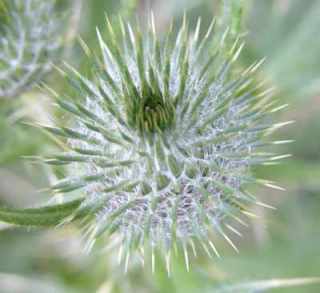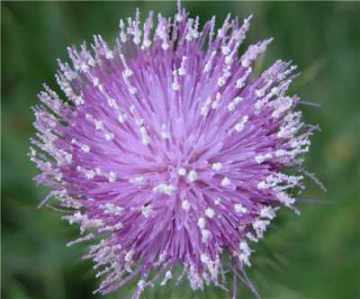Scientific Name
Cirsium vulgare (Savi) Ten
Common Names
spear thistle, black thistle (North America), Fuller's thistle (United Kingdom), karmedik (South Africa), scotch thistle (New Zealand), shaapdissel (South Africa), swamp thistle
Family
Asteraceae
Origin
Originated from Europe, Western Asia and North Africa
Habit
An erect, hairy, annual/biennial herb, which grows to about 150cm high, more commonly 60 to 120cm, reproducing by seed.
Habitat
It occurs in all Australian states except for the Northern Territory. It is a weed that occurs in a wide range of environments in pastures, particularly annual pastures, cereal crops and neglected areas. It occurs more commonly in light rainfall areas, such as sub-humid cool-temperate regions, where it grows well on exposed moderately warm sites up to subalpine levels, usually on more fertile soils. It prefers heavy soils of reasonable fertility and grows well under irrigation.
General Description
Stems and Leaves:
The stems are furrowed and winged, with spines present on the wings. The stems also have stout and cob-web like hairs. Some plants having a single unbranched stem except near the top whereas others are more branched, spreading from near the base. The leaves are fleshy, dark green in colour, and have white woolly (dense white hairs) hairs on the lower surface. The upper surface of the leaves is rough and hairy with a few scattered prickles. The rosette leaves (a cluster of leaves at the base of a plant often lying flat against the ground) are lanceolate to elliptical, and are up to 35cm long. Older leaves are deeply lobed, with spines on the margins and wart-like protuberances on the upper surface. The stem leaves are up to 25cm long, sessile (without a stalk, attached to the stem) with bases extended along stems acting as wings. The leaves are divided into lobes, the tip of each lobe ending in a stout yellow spine.
Flowers and Fruit:
The flowering heads are reddish to purple are 3-5cm in diameter. The flower heads are solitary or in groups of 2 or 3 at the end of branches, surrounded by many spiny bracts, with approximately 100 florets (an individual flower usually small forming part of a group of flowers arising from one stem) per head. The seed is 3-5mm long and 1.5mm wide and is grey or light brown in colour with brown or black longitudinal markings. It is smooth, flattened and sometimes slightly curved. The pappus (the appendages hair or scales at the top of the seed) is 2-2.5cm long and has soft feathery hairs.
Distinguishing characteristics
Pink/purple flowers, globular flowering heads. Leaves dark green with hairs and prickles on the upper surface and soft woolly hairs on the lower surface.
Sources & References
Auld BA, Meld RW (1992) 'Weeds an illustrated botanical guide to the weeds of Australia.' (Inkata Press: Melbourne)
Parsons WT, Cuthbertson EG (2001) 'Noxious weeds of Australia.' 2nd edn. (CSIRO publishing: Collingwood, Victoria)
Tamar Vallley Weed Strategy (2004) 'Spear thistle (scotch thistle)'
Prepared by Kylie Pethybridge, 2005
Checked by Carole Campbell, 2005
Updated by Justin KY Chu, July 2005
Checked by Dr Peter Michael, July 2005

